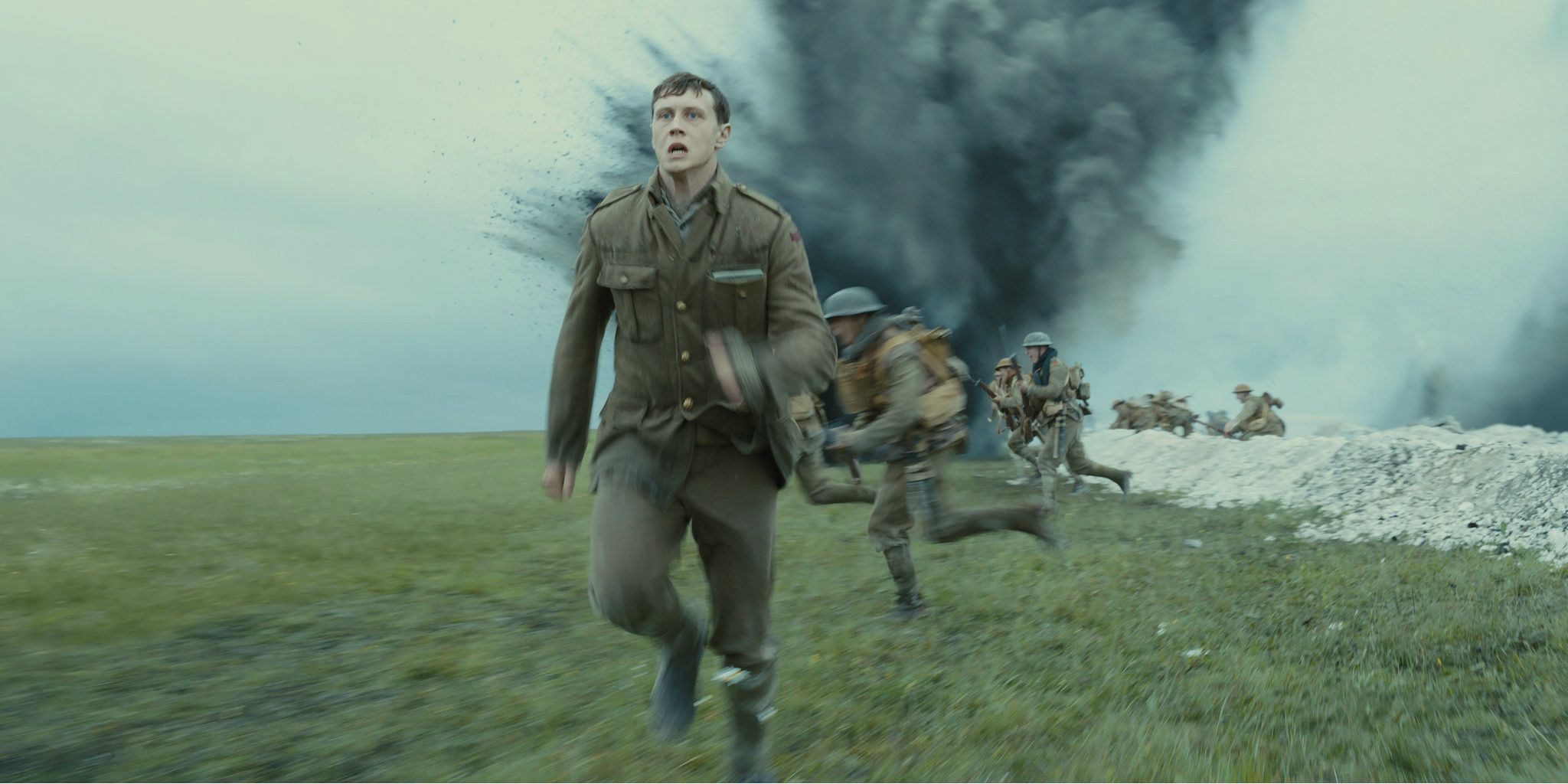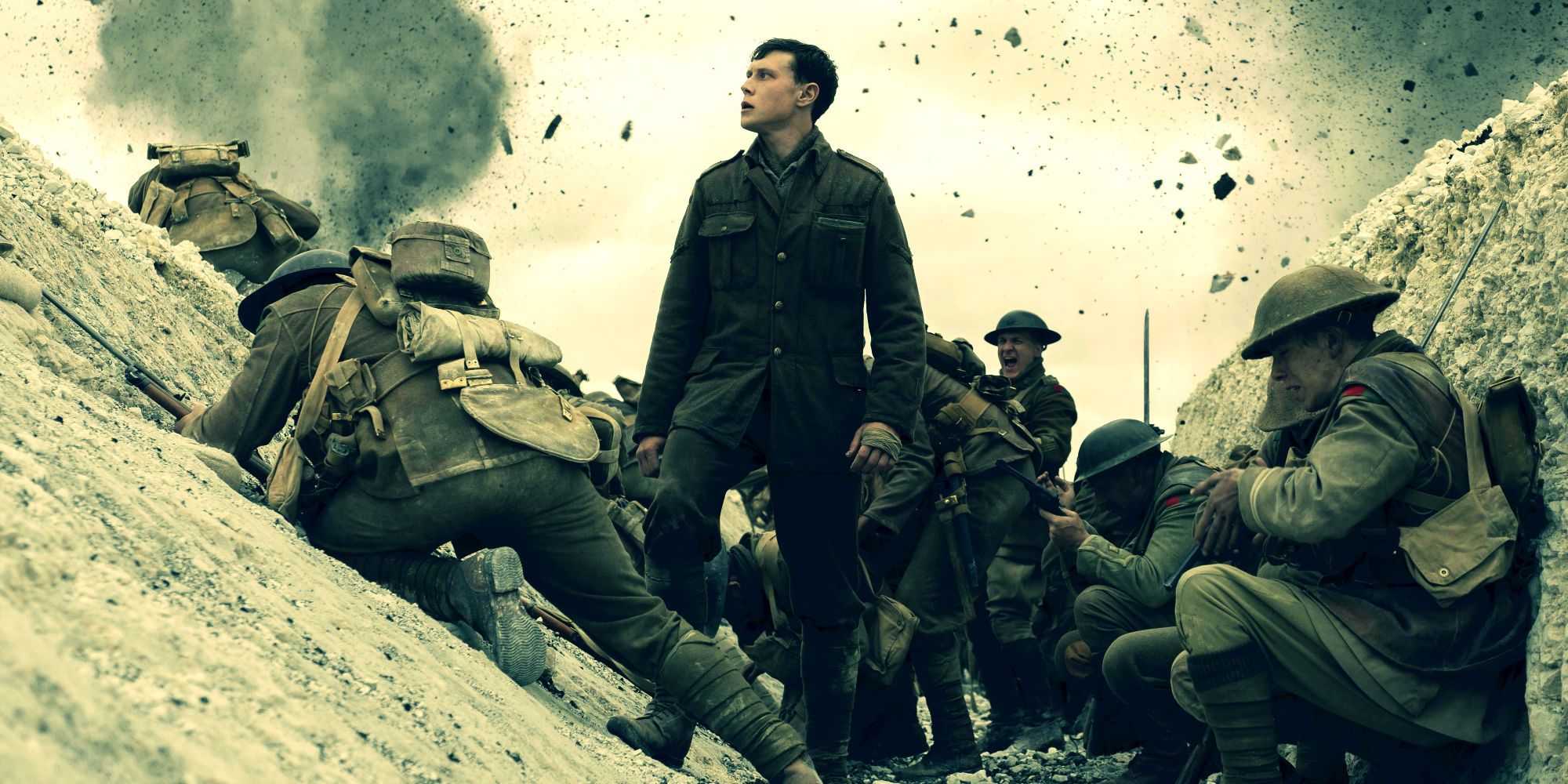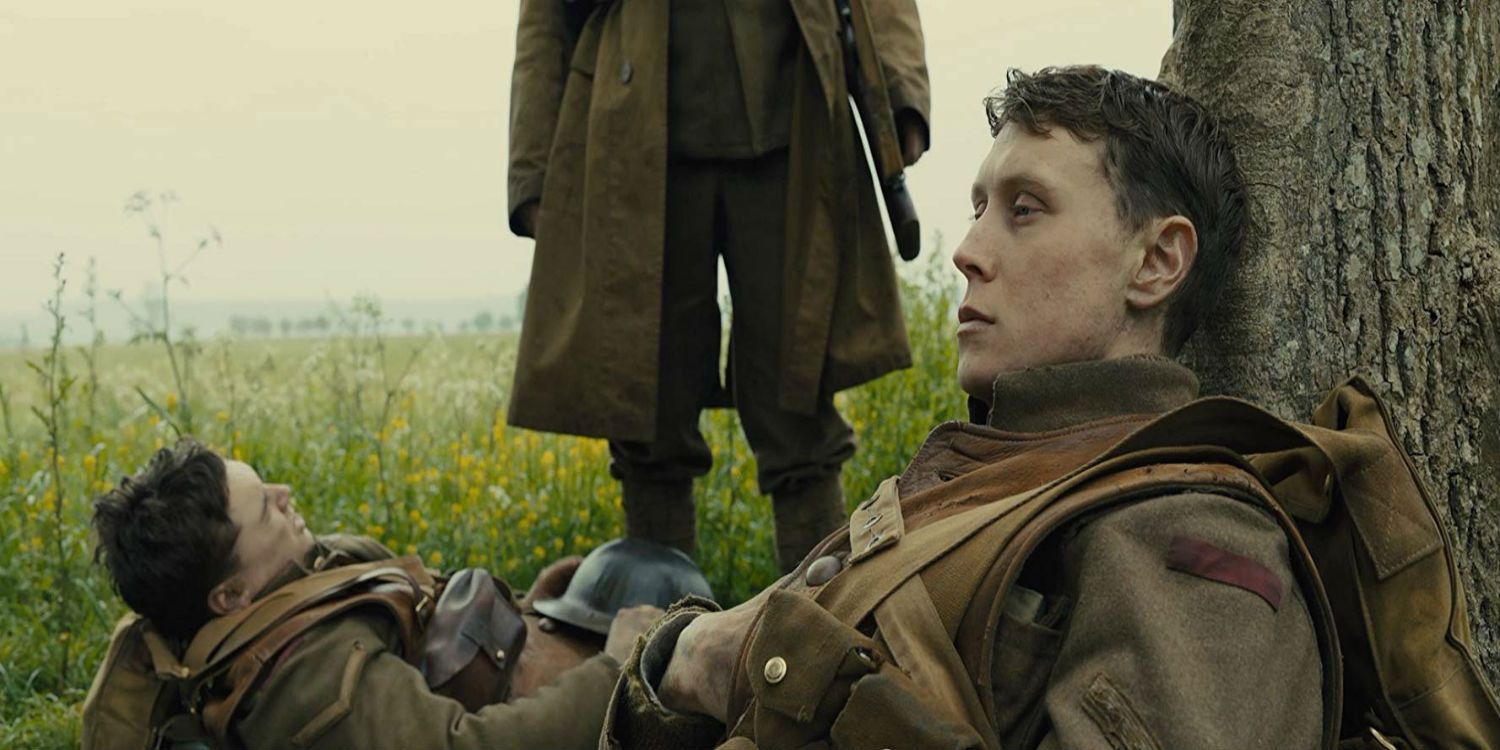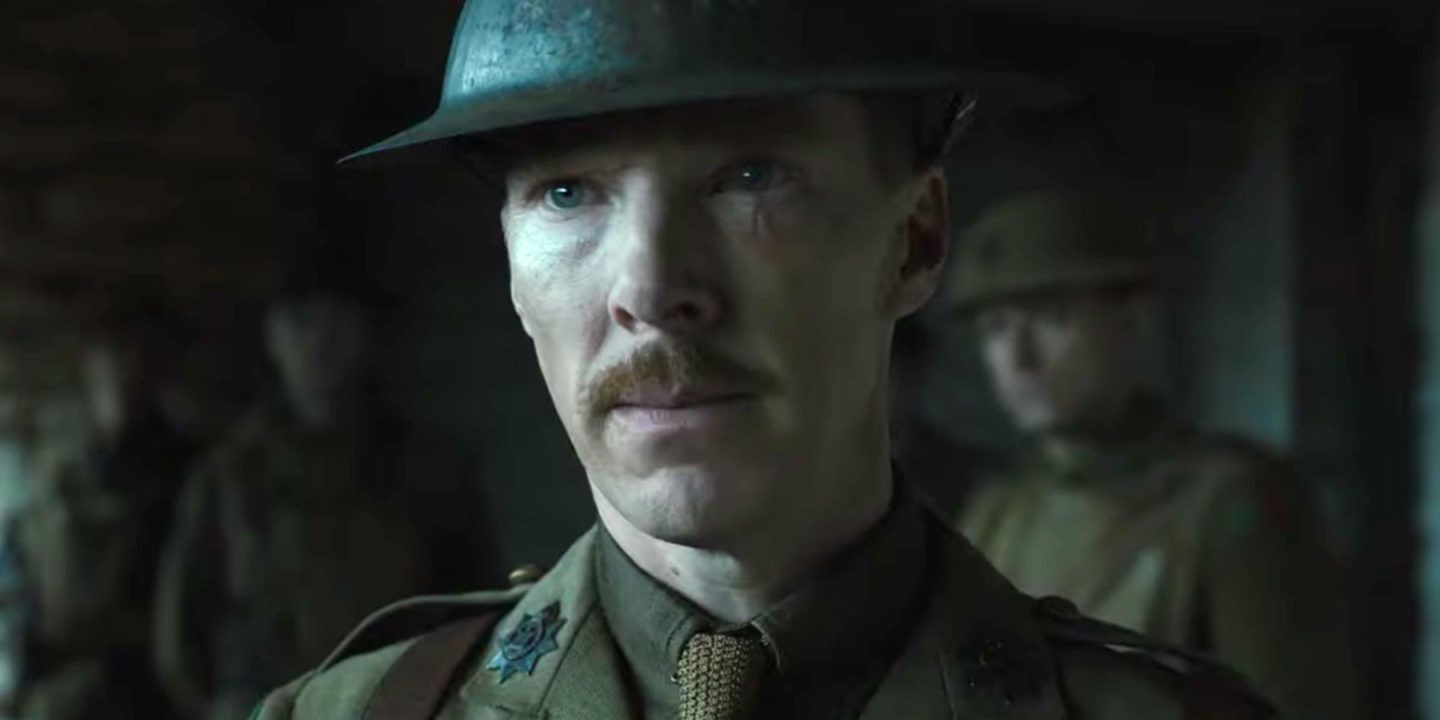The 1917 movie has a relatively straightforward story for much of its runtime – but the 1917 ending is a bit more complex than some might think. Sam Mendes’ film is an immersive, thrilling war epic that is shot to look like one long take. Because of its subject material as well as how it was filmed, 1917 quickly became an awards favorite; however, while many of the film’s accolades have come from the technical side, there is plenty to digest from a storytelling perspective as well.
1917 follows two British soldiers, Lance Corporals Will Schofield (George McKay) and Tom Blake (Dean-Charles Chapman), who are tasked with delivering a message to the Second Battalion of the Devonshire Regiment (the Second Devons). They need to tell Colonel Mackenzie (Benedict Cumberbatch) to call off a planned attack; the Germans have not fled but rather made a tactical retreat, lying in wait to ambush the British troops. Blake’s brother, Joseph, is among the members of the threatened regiment, and the two soldiers must cross enemy lines to deliver the life-or-death message.
Along the way, Blake is killed by a German pilot who crashes near them at an abandoned farmhouse. But Schofield is determined to keep going, and he faces a series of increasingly treacherous obstacles as he charges forward to the finish line.
What Happens in 1917’s Ending

1917’s ending begins with Schofield escaping German pursuit through a bombed village, while also finding a young French woman and a small child hiding amid the wreckage. Eventually, he finds the Second Devons in a nearby forest, where a member of the battalion is singing a song as they prepare to march into battle. To his dismay, Schofield learns that this is the last wave of the attack, and he must forge to the front lines to reach Colonel Mackenzie before the imminent bloodbath.
Schofield races his way through the ranks of soldiers, pushing and shoving through the trenches. He asks a number of soldiers where he can find Colonel Mackenzie, but they keep pointing him further and further down the trench line. As the attack commences, Schofield realizes he must leave the trenches and sprint across the battlefield in order to have any chance of finding Mackenzie in time. He eventually does so, and hands Mackenzie the hand-written orders to call off the attack.
After things settle down, Schofield is determined to find Blake’s brother, Joseph, in order to make sure that he was able to halt the attack before Joseph entered the battlefield. Schofield eventually finds him, who listens in horror as he learns his brother has died. Schofield gives Joseph some of Blake’s personal items, including rings and a dogtag, then asks him to write to his mother informing her that Blake died a hero. 1917 ends with Schofield sitting in a grassy field, in a parallel shot to the film’s opening, looking at an image of his wife and two young daughters.
Schofield’s Family Photos In 1917

The photo of Schofield’s wife and daughters is only revealed to the audience in 1917‘s ending. However, they explain several key moments throughout the film, and allow his character arc to come full circle. In an earlier scene, Schofield and Blake discuss their recent leave, when they got to briefly return home. In one of the few moments where Schofield reveals his emotions, he mentions that he hated his leave, because he knew he would eventually have to return to the battlefield and put his life back in danger. This moment hits twice as hard when viewers know he has a family, and the idea of him hating his time at home becomes more poignant when audiences realize he should be enjoying his time with them – but he could only think about what would happen if he were to die when he returned to the war.
There is also a key moment before 1917‘s ending where Schofield stumbles upon a French woman hiding out from German soldiers. She is caring for an infant, and Schofield gives her his canned food and the milk he found at the abandoned farm where Blake died. The woman asks Schofield to stay with him, but he refuses, still needing to forge on and complete his mission. With the hindsight of the audience knowing Schofield has children of his own, it’s showcased why he was so deeply affected in that moment. He wants to help this woman and child, but he has to keep going or else many more people will die.
Perhaps most importantly, the reveal heightens the overall stakes of Schofield’s mission. Viewers understand Blake’s personal motivations from 1917‘s outset: he wants to save his brother, and will stop at nothing to do so. Schofield seems more hesitant throughout, and after he nearly dies due to the tripwire in the German bunker, he wants to turn back. Knowing he had a family back home, this makes much more sense. But when Blake dies, the mission becomes more important to him on a personal level. He knows the Blake family has already lost one son, and he needs to succeed in his endeavor in order to save the other – despite the immense personal cost if something happens to him.
1917’s Final Shot Parallels The Very First Shot

1917 opens with a scene of Schofield lying against a tree, waking up from a nap to learn he has a mission. It ends almost the exact same way, with Schofield leaning back against a different tree to look at his family photo. Trees are an important symbol in 1917. They only appear at moments of peace: in the opening scene when the characters don’t yet know their mission, just before the climax when the soldier sings the pre-battle song, and at the end once the attack is called off and hundreds of lives have been saved. The rest of the scenes take place against the backdrop of either dirty trenches or bombed out villages.
Trees also discussed in a conversation between Blake and Schofield. At one point, both soldiers pass a field of burned out cherry trees, and Schofield laments their destruction. However, Blake explains that they’ll eventually grow back, more numerous than they were before. The trees could be a metaphor for the pervasiveness of life amid the harshness of war, which would fall in line with Schofield’s outlook on being with his family; he wants peace but understands he needs to complete a mission first to make sure there is something after its over. Things may be grim at the moment, but it’s all to create a brighter future where humanity will prosper.
Why 1917’s Ending Is So Bittersweet

1917 is an uncommonly tense, breathtaking film that ultimately hinges on one goal: to call off this one attack, on one day, that will save 1,600 lives. There is a major moment of relief (after two straight hours of chaos) when Colonel Mackenzie listens to the orders, ultimately halting the attack before any major casualties happen. But before Schofield and Mackenzie part ways, the colonel says that while this ambush will be avoided, he will likely get orders in a week to attack again. So while this mission may have been a success, it’s likely that the peace will only be temporary.
The movie obviously takes place in 1917, but World War I continued until November 1918, more than a year-and-a-half after the events depicted. This may have been a victory, but the war is far from over. There were estimated to be nearly nine million deaths among soldiers throughout the war, and while it feels vital that the 1,600 lives were saved here, it is, regrettably, nothing in the grand scheme of things. Mendes and cinematographer Roger Deakins do a fantastic job of making everything seem so urgent in this one mission – and it certainly was, at the time – but through Mackenzie’s comments, it’s abundantly clear how many more people were affected by this conflict – and how every one of the nine million lives lost had a story just like this.




